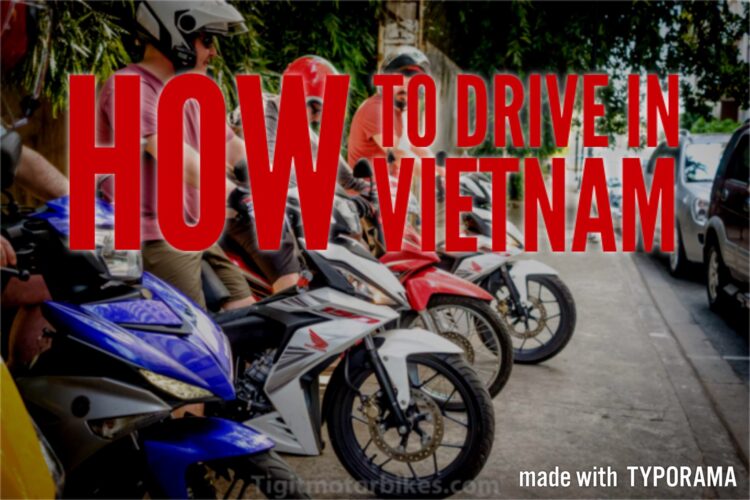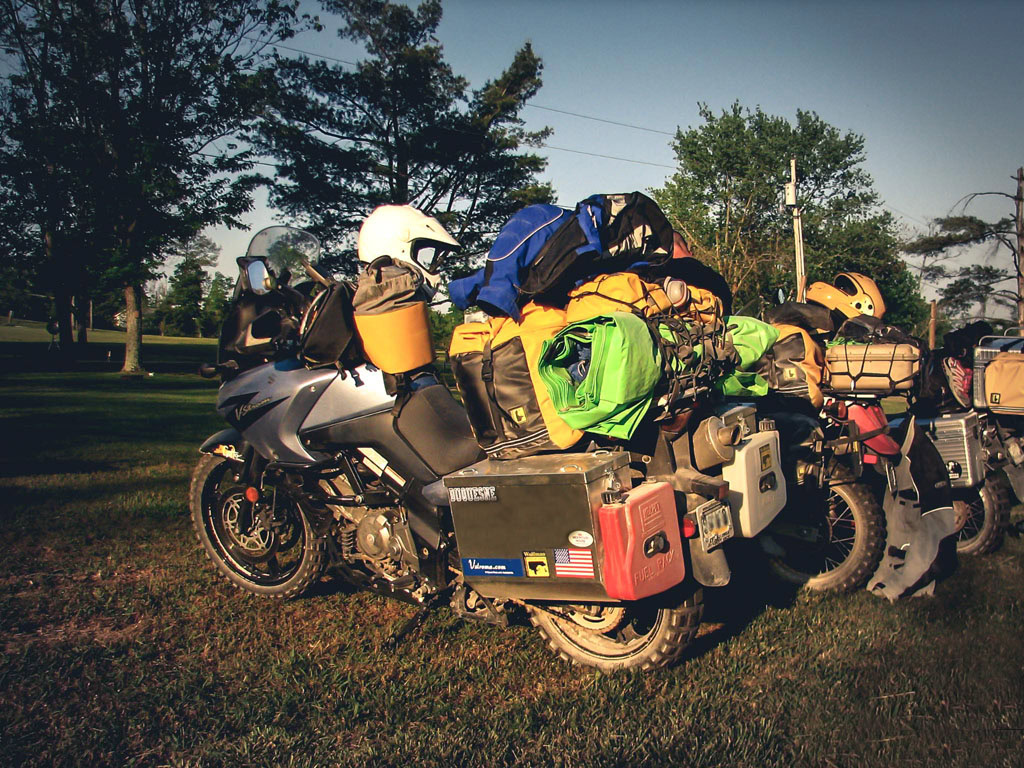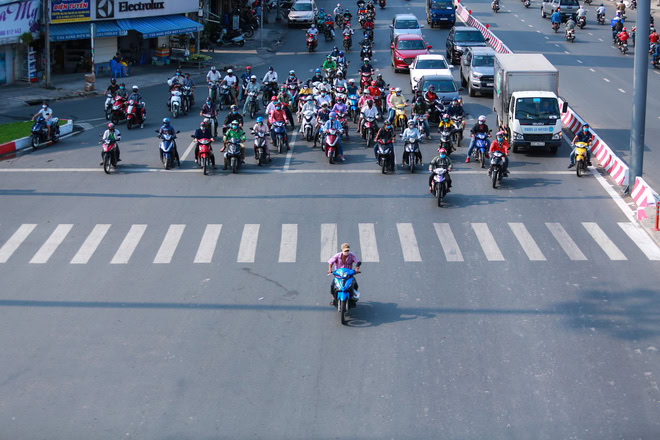Don’t drive illegally
Contents
To drive legally in Vietnam, you need a license and an international driver’s permit. However, many travelers come to Vietnam with no documentation. Police in Vietnam mostly turn a blind eye to foreigners, but simple coffee money will suffice if stopped.
Drive predictably
Vietnamese drive slowly and in predictable lines. While you will see vehicles going in all directions, it is rare to see any sudden direction changes. Slow, gradual, and predictable movements will have the swarm of motorbikes buzz around you but not into you.
Learn to drive a manual motorbike
Learn to drive a semi automatic
Understand that Vietnamese drive slowly
Vietnamese drive badly, but very slowly. Locals tend to have monovision where they only look forward. The idea of looking left and right is still coming to Vietnam. Although it is rapidly changing, it is important to understand that locals are not expecting vehicles to move at speed, so there is no big reason to focus 100% on driving. Driving with a cigarette or mobile phone in one hand is perfectly normal here.
Travelers come to Vietnam and drive at speeds they are used to back home. The locals are not expecting it and are caught off-guard, which results in crashes. It is as much the fault of the speeding traveler as it is the unfocused local.
Don’t overpack and carry too much luggage
Motorbikes do not perform well under loads. They can do it, but handling and braking distance is reduced. We have a full article on what to bring and wear when traveling Vietnam by motorbike. Purchasing a good helmet is also not a bad idea.
Expect the worst at all times
There are unwritten rules in Vietnam when it comes to driving, and it won’t be possible for a traveler to pick up on them. So when first driving in Vietnam, it will appear that locals will do anything on a motorbike. Drive up the road the wrong way, pull out of junctions without looking, and do random U-turns where unexpected. It is easy to get caught off-guard with seemingly completely irrational driving. The rationale is simple: locals are driving slowly, and they expect you to drive slowly. Keep reminding yourself of this, and the road rage should dissipate. Slow driving with the expectation of anything happening from any angle should see you through safely!
Dogs cause the most crashes at Tigit Motorbikes
When I drive, I consider pedestrians to be just as unpredictable as animals when it comes to the desire to commit suicide by crossing the road without looking. As mentioned in the points above, the solution is to drive slowly. However, in reality, dogs are the most significant cause of crashes at Tigit Motorbikes, and it is important to keep an eye out for animals darting across the road.
Traffic lights
There are unwritten rules when it comes to traffic lights. As an expat of 10 years, I understand them, but I can’t explain them. Some traffic lights can be ignored, whereas others must be diligently followed. As a traveler, you should be respecting the laws and trying to obey all traffic lights. Turning right at a red traffic light is legal here, and when stopping at red lights, you should be leaving a gap on the right curb for motorcycles to pass through. Blocking the right curb will be seen as rude and will attract some road rage.
Advanced driving in Vietnam
Understanding the use of the horn
Locals use noise instead of sight to signal their position on the road. When arriving in Vietnam, motorcycle horns’ constant beeps is one of the first things you will notice. The horn is not a sign of aggression but a signal that you are here. The horn’s abuse is perhaps a local solution for the monovision driving style where looking left and right has not yet been discovered. As a traveler, I recommend using your eyes and not your ears for driving, and I remain to be British and civilized with my use of the horn. Use your mirrors and have diligent and regular checks to understand your surroundings.
Driving fast in Vietnam
You have read the points above and decided to ignore the advice on driving slowly. Vietnam is right-hand drive, with a loose understanding of a slow lane on the right curb and a fast lane on the left lane. This can get confusing as Vietnam also has laws where the motorbike lane is on the right-hand curb, and the car lane is on the left-hand lane. This law can sometimes make it difficult for a fast-moving motorcyclist to find their place within the fast lane. The solution is to hold a firm position in the middle of the road. In the slow lane, you will find motorcyclists driving in all directions, including the wrong way up the road. It is also common to have pedestrians meandering out into the street without looking from both the right and left. A middle position in the road will give you the maximum time possible to react to both sides’ events. Unfortunately, Vietnam does not have solid central barriers, which means the fast lane still has people performing U-turns. Ultimately this element of unpredictability restricts your potential speed and must be respected.
Life and death stops at traffic lights
A long-term expat will have experienced the news events of cars and trucks smashing into the back of innocent motorcyclists patiently waiting at a traffic light. I always fight my way to the front of any traffic light and make sure I am not in the back row. I also remain focused and concentrate on having a 360 degree understanding of my position within my surroundings.
Understand that locals driving unpredictably
Earlier in the article, we talk about local drivers making slow and predictable movements. However, at speeds, these slow and predictable movements now become irrational and unpredictable. The game changes and the speeding driver must be hyper-conscious that any local can do anything at any time.
Drive fast and put the danger in front of you
In another full contradiction to the rest of this article, a truly experienced motorcyclist will find the safest way to drive in Vietnam is to be one of the fastest moving vehicles on the road. The idea is not to be speeding but to put the bad driving behind you, not in front of you. By driving faster than the average traffic, you minimize or remove the unskilled drivers’ chances of rear-ending you. A skilled driver will understand the limits of the road, the motorcycle, and themselves and safely react to all lousy driving occurring in the front view of sight.
Don’t use your mirrors
Back in the western world, we are looking for cars or large motorcycles moving in consistent and predictable straight lines. Mirrors have blind spots, but large and consistent movements can still be reliably detected. In Vietnam, we are looking for small scooters moving in unpredictable and random lines. The mirrors should still be used, especially when on highways and watching your left rear. However, the bulk of spatial awareness should be done with the naked eye. An experienced motorcyclist will have road positions and angles that allow a full head turn for a 360-degree view of their surroundings. Over-reliance on mirrors is a signal that the driver is inexperienced or driving too fast for their surroundings. You should be able to maintain a full 360-degree concept view without a mirror.
Understand your angles and never stop
A keen eye will notice that the experienced local riders will rarely come to a complete stop in the road. The big fear in Vietnam is to be re-ended, so the aim of the game is to always maintain some movement. When turning left across traffic, it is sometimes worth overshooting the left turn and performing a U-turn later down the road. Vietnam’s traffic lights have countdown timers, which allows a driver to slowly glide correctly into a green light. Sitting at red lights can be sometimes be avoided. As you progress your skills riding in Vietnam, you will naturally start to understand traffic angles and flows of moving vehicles. Over time you will develop innovative ways of maintaining movement to help keep the dangers in front of you and not behind you.



























